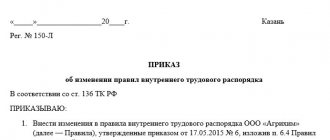Decree of the Government of the Russian Federation dated December 24, 2007 No. 922
Approved by Decree of the Government of the Russian Federation of December 24, 2007 No. 922
Regulations on the specifics of the procedure for calculating average wages
1. This Regulation establishes the specifics of the procedure for calculating average wages (average earnings) for all cases of determining its size provided for by the Labor Code of the Russian Federation (hereinafter referred to as average earnings).
2. To calculate average earnings, all types of payments provided for by the remuneration system and applied by the relevant employer are taken into account, regardless of the sources of these payments. Such payments include:
a) wages accrued to the employee at tariff rates, salaries (official salaries) for the time worked;
b) wages accrued to the employee for work performed at piece rates;
c) wages accrued to the employee for work performed as a percentage of revenue from sales of products (performance of work, provision of services), or commission;
d) wages paid in non-monetary form;
e) monetary remuneration (salary) accrued for hours worked to persons holding government positions in the Russian Federation, government positions in constituent entities of the Russian Federation, deputies, members of elected local government bodies, elected officials of local government, members of election commissions operating on a permanent basis;
f) salary accrued to municipal employees for time worked;
g) fees accrued in editorial offices of mass media and art organizations for employees on the payroll of these editorial offices and organizations, and (or) payment for their labor, carried out at the rates (rates) of author's (production) remuneration;
h) wages accrued to teachers of primary and secondary vocational education institutions for hours of teaching work in excess of the established and (or) reduced annual teaching load for the current academic year, regardless of the time of accrual;
i) wages, finally calculated at the end of the calendar year preceding the event, determined by the remuneration system, regardless of the time of accrual;
j) allowances and additional payments to tariff rates, salaries (official salaries) for professional excellence, class, length of service (work experience), academic degree, academic title, knowledge of a foreign language, work with information constituting state secrets, combination of professions (positions) , expanding service areas, increasing the volume of work performed, team management and others;
k) payments related to working conditions, including payments determined by regional regulation of wages (in the form of coefficients and percentage bonuses to wages), increased wages for hard work, work with harmful and (or) dangerous and other special conditions labor, for night work, payment for work on weekends and non-working holidays, payment for overtime work;
l) remuneration for performing the functions of a class teacher to teaching staff of state and municipal educational institutions;
m) bonuses and rewards provided for by the remuneration system;
o) other types of wage payments applicable to the relevant employer.
3. To calculate average earnings, social payments and other payments not related to wages (material assistance, payment for the cost of food, travel, training, utilities, recreation, etc.) are not taken into account.
4. The calculation of the average salary of an employee, regardless of his mode of work, is based on the salary actually accrued to him and the time actually worked by him for the 12 calendar months preceding the period during which the employee retains his average salary. In this case, a calendar month is considered to be the period from the 1st to the 30th (31st) day of the corresponding month inclusive (in February - to the 28th (29th) day inclusive).
Average daily earnings for vacation pay and compensation for unused vacations are calculated for the last 12 calendar months.
5. When calculating average earnings, time is excluded from the calculation period, as well as amounts accrued during this time, if:
a) the employee retained his average earnings in accordance with the legislation of the Russian Federation, with the exception of breaks for feeding the child provided for by the labor legislation of the Russian Federation;
b) the employee received temporary disability benefits or maternity benefits;
c) the employee did not work due to downtime due to the fault of the employer or for reasons beyond the control of the employer and employee;
d) the employee did not participate in the strike, but due to this strike he was not able to perform his work;
e) the employee was provided with additional paid days off to care for disabled children and people with disabilities since childhood;
f) the employee in other cases was released from work with full or partial retention of wages or without payment in accordance with the legislation of the Russian Federation.
6. If the employee did not have actually accrued wages or actually worked days for the billing period or for a period exceeding the billing period, or this period consisted of time excluded from the billing period in accordance with paragraph 5 of these Regulations, the average earnings are determined based on from the amount of wages actually accrued for the previous period, equal to the calculated one.
7. If the employee did not have actually accrued wages or actually worked days for the billing period and before the start of the billing period, the average earnings are determined based on the amount of wages actually accrued for the days actually worked by the employee in the month of occurrence of the event that is associated with the retention average earnings.
8. If the employee did not have actually accrued wages or actually worked days for the billing period, before the start of the billing period and before the occurrence of an event associated with maintaining the average earnings, the average earnings are determined based on the tariff rate established for him, salary (official salary ).
9. When determining average earnings, average daily earnings are used in the following cases:
to pay for vacations and pay compensation for unused vacations;
for other cases provided for by the Labor Code of the Russian Federation, except for the case of determining the average earnings of workers for whom summarized recording of working time is established.
The average employee's earnings are determined by multiplying the average daily earnings by the number of days (calendar, working) in the period subject to payment.
Average daily earnings, except in cases of determining average earnings for vacation pay and payment of compensation for unused vacations, are calculated by dividing the amount of wages actually accrued for days worked in the billing period, including bonuses and remunerations taken into account in accordance with paragraph 15 of these Regulations, by the number of days actually worked during this period.
10. Average daily earnings for payment of vacations provided in calendar days and payment of compensation for unused vacations are calculated by dividing the amount of wages actually accrued for the billing period by 12 and by the average monthly number of calendar days (29.4).
If one or more months of the billing period are not fully worked out or time is excluded from it in accordance with paragraph 5 of these Regulations, the average daily earnings are calculated by dividing the amount of actually accrued wages for the billing period by the sum of the average monthly number of calendar days (29.4) , multiplied by the number of complete calendar months, and the number of calendar days in incomplete calendar months.
The number of calendar days in an incomplete calendar month is calculated by dividing the average monthly number of calendar days (29.4) by the number of calendar days of this month and multiplying by the number of calendar days falling on the time worked in this month.
11. Average daily earnings for payment of vacations provided in working days, as well as for payment of compensation for unused vacations, are calculated by dividing the amount of actually accrued wages by the number of working days according to the calendar of a 6-day working week.
12. When working on a part-time basis (part-time, part-time), the average daily earnings to pay for vacations and pay compensation for unused vacations are calculated in accordance with paragraphs 10 and 11 of these Regulations.
13. When determining the average earnings of an employee for whom a summarized recording of working time has been established, except for the cases of determining the average earnings for paying for vacations and paying compensation for unused vacations, the average hourly earnings are used.
Average hourly earnings are calculated by dividing the amount of wages actually accrued for hours worked in the billing period, including bonuses and remunerations taken into account in accordance with paragraph 15 of these Regulations, by the number of hours actually worked during this period.
Average earnings are determined by multiplying average hourly earnings by the number of working hours according to the employee’s schedule in the period subject to payment.
14. When determining the average earnings for payment of additional educational leaves, all calendar days (including non-working holidays) falling during the period of such leaves provided in accordance with the educational institution’s certificate are subject to payment.
15. When determining average earnings, bonuses and remuneration are taken into account in the following order:
monthly bonuses and rewards – actually accrued in the billing period, but no more than one payment for each indicator for each month of the billing period;
bonuses and remunerations for a period of work exceeding one month - actually accrued in the billing period for each indicator, if the duration of the period for which they are accrued does not exceed the duration of the billing period, and in the amount of the monthly part for each month of the billing period, if the duration of the period for which they are accrued exceeds the duration of the billing period;
remuneration based on the results of work for the year, a one-time remuneration for length of service (work experience), other remunerations based on the results of work for the year, accrued for the calendar year preceding the event - regardless of the time the remuneration was accrued.
If the time falling within the billing period is not fully worked or time is excluded from it in accordance with paragraph 5 of these Regulations, bonuses and remunerations are taken into account when determining average earnings in proportion to the time worked in the billing period, with the exception of bonuses accrued for actual hours worked. time in the billing period (monthly, quarterly, etc.).
If an employee has worked an incomplete working period for which bonuses and rewards are accrued, and they were accrued in proportion to the time worked, they are taken into account when determining average earnings based on the amounts actually accrued in the manner established by this paragraph.
16. When tariff rates, salaries (official salaries), and monetary remuneration increase in an organization (branch, structural unit), the average earnings of employees increase in the following order:
if the increase occurred during the billing period, payments taken into account when determining average earnings and accrued in the billing period for the period of time preceding the increase are increased by coefficients that are calculated by dividing the tariff rate, salary (official salary), monetary remuneration established in the month of the last increases in tariff rates, salaries (official salaries), monetary remuneration, by tariff rates, salaries (official salaries), monetary remuneration established in each month of the billing period (paragraph as amended, put into effect on November 26, 2009 by Decree of the Government of the Russian Federation dated November 11, 2009 No. 916, - see previous edition);
if the increase occurred after the billing period before the occurrence of an event that is associated with maintaining the average earnings, the average earnings calculated for the billing period increase;
if the increase occurred during the period of maintaining average earnings, part of the average earnings increases from the date of increase in the tariff rate, salary (official salary), monetary remuneration until the end of the specified period.
If, when an organization (branch, structural unit) increases tariff rates, salaries (official salaries), monetary remuneration, the list of monthly payments to tariff rates, salaries (official salaries), monetary remuneration and (or) their amounts changes, average earnings increase by coefficients that are calculated by dividing the newly established tariff rates, salaries (official salaries), monetary remuneration and monthly payments by the previously established tariff rates, salaries (official salaries), monetary remuneration and monthly payments (the paragraph was additionally included from November 26, 2009 by the Resolution Government of the Russian Federation dated November 11, 2009 No. 916).
When increasing average earnings, tariff rates, salaries (official salaries), monetary remuneration and payments established to tariff rates, salaries (official salaries), monetary remuneration in a fixed amount (interest, multiple), with the exception of payments established to tariff rates, are taken into account. salaries (official salaries), monetary remuneration in a range of values (percentage, multiple).
When average earnings increase, payments taken into account when determining average earnings, established in absolute amounts, do not increase.
17. The average earnings determined to pay for the time of forced absence are subject to increase by a coefficient calculated by dividing the tariff rate, salary (official salary), monetary remuneration established for the employee from the date of actual start of work after his restoration to his previous job, by the tariff rate, salary (official salary), monetary remuneration established in the billing period, if during the forced absence in the organization (branch, structural unit) tariff rates, salaries (official salaries), monetary remuneration were increased.
At the same time, in relation to payments established in a fixed amount and in an absolute amount, the procedure established by paragraph 16 of these Regulations applies.
18. In all cases, the average monthly earnings of an employee who has worked the full working hours during the billing period and fulfilled labor standards (job duties) cannot be less than the minimum wage established by federal law.
19. For persons working part-time, the average earnings are determined in the manner established by these Regulations.
Calculation of the indicator
Clause 4 of the Regulations establishes the procedure for calculating average earnings. It is quite simple: all earnings for the 12 months preceding the period of saving earnings are taken (according to clause 2 of the Regulations). The following period is considered a calendar month:
- from the 1st to the 30th of the month;
- from the 1st to the 31st (depending on the number of days in the month);
- in February - from the 1st to the 28th or 29th.
Also, based on data for the last 12 calendar months, the average daily earnings are determined (to pay for vacation or calculate compensation for its unused period).
When is the best time to take a vacation in 2020?
Excluded periods
They are indicated in clause 5 (the amounts accrued during this time are not included in the total amount of funds when calculating average earnings):
- periods when the employee’s average earnings are maintained (except for breaks established for feeding);
- periods of receiving benefits in connection with the onset of disability, as well as the onset of pregnancy or childbirth;
- period of downtime caused by the employer’s administration;
- the period of the strike (if the employee did not participate in it, but could not perform the work);
- the period of being on paid days off to care for a disabled child.
If for a specified period of 12 months the employee did not have accrued earnings (did not work or earnings were not accrued for any reason), the indicator is determined based on the salary or tariff rate (clause 9 of the Regulations).






